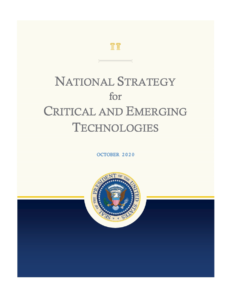On February 8th, the Office of Science and Technology Policy (OSTP) and National Science and Technology Council (NSTC) published an update to a document from October, 2020, titled “National Strategy for Critical and Emerging Technologies.” In the original document, Critical and Emerging Technologies (CETs) “…are defined as those technologies that have been identified and assessed by the National Security Council (NSC) to be critical, or to potentially become critical, to the United States’ national security advantage, including military, intelligence, and economic advantages.” The document ends with an annex that lists 20 broadly-categorized technological areas — the CETs. Looking at the report, we can see that additive manufacturing (AM) will likely be associated with many of them.

Whereas the 2020 document begins by starkly contrasting the U.S. to “strategic competitors” China and Russia, the updated list starts by pointing out that the 2021 Interim National Security Strategic Guidance document “defines three national security objectives: protect the security of the American people, expand economic prosperity and opportunity, and realize and defend democratic values.” These have been fairly standard American governmental cliches for the past eight-or-so decades, and their mention is still implicitly meant to draw a distinction between the U.S. and its Eurasian competition. As for the updates to the October, 2020 list, they entail anatomizing in greater specificity the original 20 named areas that the executive branch considers CETs.
For instance, whereas the original document merely refers to “Artificial Intelligence (AI)”, the updated list includes seven bullet points under that heading, listing subcategories of or elaborations to what is meant by “AI”, such as “Machine learning”, “Deep learning”, and “Sensory perception and recognition”. Similarly, the heading originally designated “Advanced Manufacturing” now includes four subheadings: “Additive manufacturing”, “Clean, sustainable manufacturing”, “Smart manufacturing”, and “Nanomanufacturing”.
Readers of the whole list — it’s only four pages long, for what it’s worth — who have a particular interest in the technologies encompassed by the terms AM or 3D printing will notice, not only that AM is mentioned by name, but, even more significantly, that AM overlaps with virtually every other major category that is listed. Indeed, under the aforementioned “Advanced Manufacturing” heading, alone, aside from AM, all three of the other bullet points can be considered either iterations of AM, or descriptors which would include AM as one example fitting the description.
The other most notable areas of overlap include the entirety of the bullet points under the “Advanced Engineering Materials” heading; the bullet point “Aerospace, maritime, and industrial development and production technologies” under “Advanced Gas Turbine Engine Technologies”; and the bullet point “Biomanufacturing and bioprocessing technologies” under “Biotechnologies” (for just some of the coverage of these overlaps on 3DPrint, see here, here, and here, respectively). But, again, it’s no exaggeration to say that AM overlaps with basically the whole rest of the list.
That reemphasizes a topic covered extensively on 3DPrint, which is the holistic nature of the various technologies usually subsumed under the buzzword label “Industry 4.0”. That point is also concisely stated in the original October, 2020 policy statement on CETs: “…[this document] encourages unity of effort across the United States Government and provides a framework from which deliberate actions will affect multiple technology areas in a coordinated manner. …many technology breakthroughs occur at the intersection of two or more disparate technologies. Therefore, a holistic approach is required to address the growing convergence of technologies for various applications”. This both signals a central role of AM in the evolution of overall U.S. military and intelligence policy in the future, as well as sheds light on the increasing amount of resources and attention it has been receiving from defense-related sectors in recent years.
Subscribe to Our Email Newsletter
Stay up-to-date on all the latest news from the 3D printing industry and receive information and offers from third party vendors.
Print Services
Upload your 3D Models and get them printed quickly and efficiently.
You May Also Like
3D Printing News Briefs, July 2, 2025: Copper Alloys, Defense Manufacturing, & More
We’re starting off with metals in today’s 3D Printing News Briefs, as Farsoon has unveiled a large-scale AM solution for copper alloys, and Meltio used its wire-laser metal solution to...
3DPOD 260: John Hart on VulcanForms, MIT, Desktop Metal and More
John Hart is a Professor at MIT; he´s also the director of the Laboratory for Manufacturing and Productivity as well as the director of the Center for Advanced Production Technologies....
3D Printing News Briefs, June 28, 2025: Defense Accelerator, Surgical Models, & More
In this weekend’s 3D Printing News Briefs, 3YOURMIND was selected to join an EU Defense Accelerator, and PTC has announced model-based definition (MBD) capabilities within Onshape. Finally, a study out...
EOS in India: AM’s Rising Star
EOS is doubling down on India. With a growing base of aerospace startups, new government policies, and a massive engineering workforce, India is quickly becoming one of the most important...

































